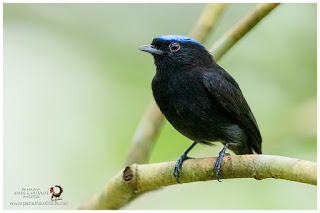 |
| Blue-crowned Manakin (Lepidothrix coronata) - male |
The
Blue-crowned Manakin (Lepidothrix coronata) is a widespread member of the
Manakin family that is characterized by its
rich blue crown. It measures 8 to 9 cm (3.15" to 3.54”).
 |
| Blue-crowned Manakin (Lepidothrix coronata) - male |
It ranges from the Pacific slope of Costa Rica and Panama south to northwestern Ecuador, as well as through much of western Amazonia including eastern Ecuador, eastern Peru, southern Colombia and Venezuela, and south through western Brazil to northern Bolivia. Throughout much of its range, the overall plumage is sooty black with a blue crown, but in southeastern Peru, southwestern Brazil and northern Bolivia, the body is almost lime green with a yellow lower belly, and lighter blue crown. Iris rather dark brown-red.
 |
| Blue-crowned Manakin (Lepidothrix coronata) - male |
 |
| Blue-crowned Manakin (Lepidothrix coronata) - male |
It is found mainly in subtropical or tropical humid lowland forests, mature secondary woodland and heavily degraded former forest to 1,400 m (4,590 ft), mostly below 1,000 m (3,280 ft). In Panama it’s common on entire Caribbean slope; also on Pacific slope in western Chiriquí, from Canal Area eastward to Colombia, and Veraguas’ foothills; found in lower levels of forest.
 |
| Blue-crowned Manakin (Lepidothrix coronata) - female |
 |
| Blue-crowned Manakin (Lepidothrix coronata) - female |
It overlaps with a number of other lowland manakins throughout its range. Female manakins always present a challenge in identification, but female Blue-crowned is noticeably “blue-green” in coloration, as compared to either olive-green or even grayish-green in other species. Leks of Blue-crowned Manakin are not as concentrated as they are with many manakin species, with calling males widely distributed through the forest.
 |
| Blue-crowned Manakin (Lepidothrix coronata) - female |
It mainly forages by hover-gleaning small fruits; also insects. Items plucked from foliage or twigs in flight.










Comments
Post a Comment